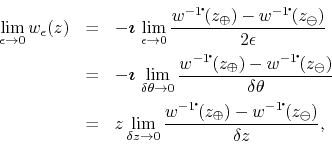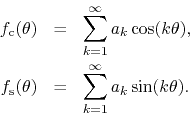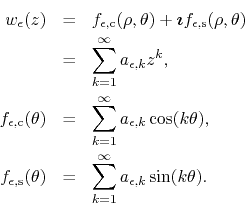Next: Higher-Order Filters Up: Fourier Theory on the Previous: Introduction
According to the correspondence established in [1], to each FC
pair of DP Fourier series corresponds an inner analytic function ![]() within the open unit disk. Each operation performed on the DP Fourier
series corresponds to a related operation on the inner analytic function,
possibly represented by its Taylor series around the origin. For example,
differentiation of the DP Fourier series with respect to their real
variable
within the open unit disk. Each operation performed on the DP Fourier
series corresponds to a related operation on the inner analytic function,
possibly represented by its Taylor series around the origin. For example,
differentiation of the DP Fourier series with respect to their real
variable ![]() corresponds to logarithmic differentiation of
corresponds to logarithmic differentiation of ![]() with respect to
with respect to ![]() , as shown in [2]. If we imagine that the
first-order low-pass filter is to be implemented on the DP real functions
, as shown in [2]. If we imagine that the
first-order low-pass filter is to be implemented on the DP real functions
![]() and
and
![]() associated to the DP Fourier
series, where for
associated to the DP Fourier
series, where for
![]() and
and ![]() we have
we have
then it is clear that a corresponding filtering operation over ![]() must
exist within the open unit disk. In this section we will give the
definition of this filtering operation on the complex plane, and derive
some of its properties.
must
exist within the open unit disk. In this section we will give the
definition of this filtering operation on the complex plane, and derive
some of its properties.
Consider then an inner analytic function ![]() , with
, with
![]() and
and
![]() . We define from it the
corresponding filtered complex function, using the real angular range
parameter
. We define from it the
corresponding filtered complex function, using the real angular range
parameter
![]() , by
, by
involving an integral over the arc of circle illustrated in Figure 1, where the two extremes are given by

 |
It is important to observe that this definition can be implemented at all
the points of the unit disk, with the single additional proviso that at
![]() the filter be defined as the identity. Note that the definition in
Equation (3) has the form of a logarithmic integral, which is
the inverse operation to the logarithmic derivative, as defined and
discussed in [2]. What we are doing here is to map the value
of the function
the filter be defined as the identity. Note that the definition in
Equation (3) has the form of a logarithmic integral, which is
the inverse operation to the logarithmic derivative, as defined and
discussed in [2]. What we are doing here is to map the value
of the function ![]() at
at ![]() to the average of
to the average of ![]() over the symmetric
arc of circle of angular length
over the symmetric
arc of circle of angular length ![]() around
around ![]() , with constant
, with constant
![]() . This defines a new complex function
. This defines a new complex function
![]() at that
point. Since on the arc of circle we have that
at that
point. Since on the arc of circle we have that
![]() and hence that
and hence that
![]() , we may also write the definition as
, we may also write the definition as

which makes the averaging process explicitly clear. As one might expect,
just as the logarithmic differentiation of inner analytic functions
corresponds to derivatives with respect to ![]() , the logarithmic
integration corresponds to integrals on
, the logarithmic
integration corresponds to integrals on ![]() . Note that for
. Note that for
![]() the complex filtered function
the complex filtered function
![]() is simply a
constant function, possibly with removable singularities on the unit
circle. Since our real functions here, being the real or imaginary parts
of inner analytic functions, are zero-average functions, that constant is
actually zero, for all inner analytic functions.
is simply a
constant function, possibly with removable singularities on the unit
circle. Since our real functions here, being the real or imaginary parts
of inner analytic functions, are zero-average functions, that constant is
actually zero, for all inner analytic functions.
Let us show that
![]() is an inner analytic function, as
defined in [1]. Note that since
is an inner analytic function, as
defined in [1]. Note that since ![]() is an inner analytic
function, it has the property that
is an inner analytic
function, it has the property that ![]() . Therefore we see that because
. Therefore we see that because
![]() the integrand in Equation (3) is analytic within the
open unit circle, if defined by continuity at
the integrand in Equation (3) is analytic within the
open unit circle, if defined by continuity at ![]() . Consider therefore
the integral over the closed oriented circuit shown in Figure 1,
. Consider therefore
the integral over the closed oriented circuit shown in Figure 1,
Since the contour is closed and the integrand is analytic on it and within it, this integral is zero due to the Cauchy-Goursat theorem. It follows that we have

These last two integrals give the logarithmic primitive of ![]() at the
two ends of the arc, as defined in [2]. According to that
definition the logarithmic primitive of
at the
two ends of the arc, as defined in [2]. According to that
definition the logarithmic primitive of ![]() is given by
is given by
where we are using the notation for the logarithmic primitive introduced
in that paper. The logarithmic primitive
![]() is an inner
analytic function within the open unit disk, as shown in [2].
It follows that we have
is an inner
analytic function within the open unit disk, as shown in [2].
It follows that we have

Since the logarithmic primitive
![]() is an inner analytic
function, and since the functions
is an inner analytic
function, and since the functions
![]() and
and ![]() are
also rotated inner analytic functions, as can easily be verified, it is
reasonable to think that the right-hand side of this equation is an inner
analytic function. We have therefore for the filtered complex function
are
also rotated inner analytic functions, as can easily be verified, it is
reasonable to think that the right-hand side of this equation is an inner
analytic function. We have therefore for the filtered complex function
which indicates that
![]() is an inner analytic function as
well. In fact, the analyticity of
is an inner analytic function as
well. In fact, the analyticity of
![]() is evident, since it
is a linear combination of two analytic functions within the open unit
disk. We must also show that
is evident, since it
is a linear combination of two analytic functions within the open unit
disk. We must also show that
![]() and that
and that
![]() reduces to a real function on the interval
reduces to a real function on the interval ![]() of
the real axis, which are the additional properties defining an inner
analytic function, as given in [1]. It is easy to check
directly that
of
the real axis, which are the additional properties defining an inner
analytic function, as given in [1]. It is easy to check
directly that
![]() , since
, since
![]() , given that
the logarithmic primitive is an inner analytic function. In order to
establish the remaining property, we replace
, given that
the logarithmic primitive is an inner analytic function. In order to
establish the remaining property, we replace ![]() by a real
by a real ![]() in the
filtered function, and taking the complex conjugate of that function with
argument
in the
filtered function, and taking the complex conjugate of that function with
argument ![]() we get
we get
Now, since
![]() is an inner analytic function, it follows
that
is an inner analytic function, it follows
that
![]() is a real function. Therefore the only relevant
participation of the number
is a real function. Therefore the only relevant
participation of the number
![]() in the quantity within the brackets in
the expression above is that introduced explicitly via the arguments. We
have therefore, taking the complex conjugates on the right-hand side,
in the quantity within the brackets in
the expression above is that introduced explicitly via the arguments. We
have therefore, taking the complex conjugates on the right-hand side,
![\begin{eqnarray*}
w_{\epsilon}^{*}(x)
& = &
\frac{\mbox{\boldmath$\imath$}}{2...
...$\imath$}\epsilon}\right)
\right]
\\
& = &
w_{\epsilon}(x),
\end{eqnarray*}](img97.png)
so that
![]() reduces to a real function on the interval
reduces to a real function on the interval
![]() of the real axis. This establishes, therefore, that the filtered
complex function
of the real axis. This establishes, therefore, that the filtered
complex function
![]() is in fact an inner analytic function.
In addition to this, since logarithmic integration softens the
singularities of
is in fact an inner analytic function.
In addition to this, since logarithmic integration softens the
singularities of ![]() by one degree, as discussed in [2], we
see that
by one degree, as discussed in [2], we
see that
![]() will have all its singularities softened by one
degree as compared to those of
will have all its singularities softened by one
degree as compared to those of ![]() .
.
Observe that, if we take the limit ![]() to the unit circle in such
a way that
to the unit circle in such
a way that ![]() tends to a singularity of
tends to a singularity of ![]() at the position
at the position ![]() ,
it immediately follows that
,
it immediately follows that
![]() has two singularities, each
softened by one degree, at the positions
has two singularities, each
softened by one degree, at the positions
![]() and
and
![]() . What we have here is what we will refer to as the
process of singularity splitting, for we see that the application of
the filter has the effect of interchanging a harder singularity at
. What we have here is what we will refer to as the
process of singularity splitting, for we see that the application of
the filter has the effect of interchanging a harder singularity at
![]() by two softer singularities at
by two softer singularities at
![]() and
and
![]() . In particular, this will always decrease the degree
of hardness, or increase the degree of softness, of all the dominant
singularities on the unit circle, by one degree. This in turn is important
because the dominant singularities determine the level and mode of
convergence of the DP Fourier series, as discussed in [2].
. In particular, this will always decrease the degree
of hardness, or increase the degree of softness, of all the dominant
singularities on the unit circle, by one degree. This in turn is important
because the dominant singularities determine the level and mode of
convergence of the DP Fourier series, as discussed in [2].
Observe that the filtering operation does not stay within a single
integral-differential chain of inner analytic functions, as defined
in [2], since it changes the location of the singularities of
the inner analytic function it is applied to. Instead, it passes to
another such chain, while at the same time changing to the next link in
the new chain, in the softening direction, since it softens the
singularities by one degree. The new function reached in this way is not
directly related to the original one by straight logarithmic
integration. The new function is, however, close to the original function,
so long as ![]() is small, according to a criterion that has a clear
physical meaning, as explained in [3].
is small, according to a criterion that has a clear
physical meaning, as explained in [3].
Since the complex-plane definition of the first-order low-pass filter in
the open unit disk reproduces the definition of the filter as given in
Equation (1) directly in terms of the corresponding real
functions on the unit circle, it also reproduces all the properties of the
filter when acting on the real functions, which were discussed and
demonstrated in [3]. In some cases there are corresponding
properties of the filter in terms of the complex functions. By
construction it is clear that, just as ![]() , the function
, the function
![]() is periodic in
is periodic in ![]() , with period
, with period ![]() , which is a
generalization to the complex plane of one of the properties of the
filter [9]. In addition to this, since it acts on inner
analytic functions, which are analytic and thus always continuous and
differentiable, it is quite clear that the filter becomes the identity
operation in the
, which is a
generalization to the complex plane of one of the properties of the
filter [9]. In addition to this, since it acts on inner
analytic functions, which are analytic and thus always continuous and
differentiable, it is quite clear that the filter becomes the identity
operation in the ![]() limit. We can see this from the
complex-plane definition in Equation (5). If we consider the
variation of
limit. We can see this from the
complex-plane definition in Equation (5). If we consider the
variation of ![]() between
between ![]() and
and ![]() , which is
given in terms of the parameter
, which is
given in terms of the parameter ![]() by
by
![]() ,
and we take the
,
and we take the ![]() limit of that expression, we get
limit of that expression, we get

where we used the fact that in the limit
![]() .
The limit above defines the logarithmic derivative, so that we have
.
The limit above defines the logarithmic derivative, so that we have

since we have the logarithmic derivative of the logarithmic primitive, and
the operations of logarithmic differentiation and logarithmic integration
are the inverses of one another. This establishes that in the ![]() limit the filter becomes the identity when acting on the inner analytic
functions, which is a generalization to the complex plane of another
property of the filter [7]. In fact, this property within the
open unit disk is somewhat stronger than the corresponding property on the
unit circle, since in this case we have exactly the identity in all cases,
while in the real case we had only the identity almost everywhere.
limit the filter becomes the identity when acting on the inner analytic
functions, which is a generalization to the complex plane of another
property of the filter [7]. In fact, this property within the
open unit disk is somewhat stronger than the corresponding property on the
unit circle, since in this case we have exactly the identity in all cases,
while in the real case we had only the identity almost everywhere.
Taken in the light of the classification of singularities and modes of convergence which was given in [2], we can see immediately the consequences of this process of singularity splitting on the mode of convergence of the DP Fourier series associated to the inner analytic function, and on the analytic character of the corresponding DP real functions. Let us recall from the earlier papers [1] and [2] that given an inner analytic function
where
![]() , and its Taylor series around
, and its Taylor series around ![]() ,
,

which is convergent at least on the open unit disk, it follows that on the
unit circle we have the real functions
![]() and
and
![]() , associated to
the FC pair of DP Fourier series
, associated to
the FC pair of DP Fourier series

After the action of the filter we have corresponding relations for the filtered functions,

The results obtained in [2] relate the nature of the dominant
singularities of ![]() on the unit circle with the mode of convergence of
the corresponding DP Fourier series and with the analytical character of
the corresponding DP real functions
on the unit circle with the mode of convergence of
the corresponding DP Fourier series and with the analytical character of
the corresponding DP real functions
![]() and
and
![]() , for a large class of inner analytic functions and
corresponding DP real functions. The same relations also hold for
, for a large class of inner analytic functions and
corresponding DP real functions. The same relations also hold for
![]() , of course. Assuming that the functions at issue here
are within that class, we may derive some of the properties of the
first-order low-pass filter, as defined on the complex plane.
, of course. Assuming that the functions at issue here
are within that class, we may derive some of the properties of the
first-order low-pass filter, as defined on the complex plane.
For one thing, if the original real functions are continuous, then
according to the classification introduced in [2] the original
inner analytic function has dominant singularities that are soft, with any
degree of softness starting from borderline soft singularities (that is,
with degree of softness zero), and the DP Fourier series are absolutely
and uniformly convergent. In this case the action of the filter results in
an inner analytic function with dominant singularities that have a degree
of softness equal to ![]() or larger, thus implying that the corresponding
filtered real functions are differentiable. We thus reproduce in the
complex formalism one of the properties of the first-order
filter [5], namely that if a real function is continuous then
the corresponding filtered function is differentiable.
or larger, thus implying that the corresponding
filtered real functions are differentiable. We thus reproduce in the
complex formalism one of the properties of the first-order
filter [5], namely that if a real function is continuous then
the corresponding filtered function is differentiable.
In addition to this, if the original real functions are integrable but not continuous, then according to the classification introduced in [2] the original inner analytic function has dominant singularities that are borderline hard ones (that is, with degree of hardness zero), and the DP Fourier series are convergent almost everywhere, but not absolutely or uniformly convergent. In this case the action of the filter results in an inner analytic function with dominant singularities which are borderline soft, thus implying that the corresponding filtered real functions are continuous. Also, in this case the filtered DP Fourier series become absolutely and uniformly convergent. We thus reproduce in the complex formalism another one of the properties of the first-order filter [6], namely that if a real function is discontinuous then the corresponding filtered function is continuous.
Since the filter acts only on the variable ![]() , some of the
properties of the filter defined on the real line, and hence on the unit
circle, are translated transparently to the complex formalism. For
example, the action on the filter on the Fourier expansions encoded into
the angular part of the complex Taylor expansions is determined by its
action on the elements of the Fourier basis, as shown
in [10,11]. If we apply the filter as defined in
Equation (4) to the functions of the basis we get
, some of the
properties of the filter defined on the real line, and hence on the unit
circle, are translated transparently to the complex formalism. For
example, the action on the filter on the Fourier expansions encoded into
the angular part of the complex Taylor expansions is determined by its
action on the elements of the Fourier basis, as shown
in [10,11]. If we apply the filter as defined in
Equation (4) to the functions of the basis we get
![\begin{eqnarray*}
\frac{1}{2\epsilon}
\int_{\theta-\epsilon}^{\theta+\epsilon}...
...t[
\frac{\sin(k\epsilon)}{(k\epsilon)}
\right]
\sin(k\theta).
\end{eqnarray*}](img113.png)
This means that the elements of that basis are eigenfunctions of the
filter, interpreted as an operator. It also determines the eigenvalues,
given by the ratio shown within brackets, which is known as the sinc
function of the variable ![]() . What this means is that the filter
acts of an extremely simple way on the Fourier expansions. It then follows
that the same is true, of course, for the Taylor series of the
corresponding inner analytic functions. If we write the Taylor expansion
of a given inner analytic function in polar coordinates, with
. What this means is that the filter
acts of an extremely simple way on the Fourier expansions. It then follows
that the same is true, of course, for the Taylor series of the
corresponding inner analytic functions. If we write the Taylor expansion
of a given inner analytic function in polar coordinates, with
![]() , we get
, we get
![\begin{displaymath}
w(z)
=
\sum_{k=1}^{\infty}
a_{k}
\rho^{k}
\left[
\cos(k\theta)
+
\mbox{\boldmath$\imath$}
\sin(k\theta)
\right],
\end{displaymath}](img115.png)
and from this follows at once the corresponding expansion for the filtered function
![\begin{displaymath}
w_{\epsilon}(z)
=
\sum_{k=1}^{\infty}
a_{k}
\left[
\fr...
...k\theta)
+
\mbox{\boldmath$\imath$}
\sin(k\theta)
\right].
\end{displaymath}](img116.png)
What this means is that the Taylor coefficients
![]() of
of
![]() are given by
are given by
in terms of the Taylor coefficients ![]() of
of ![]() , a fact that can be
shown directly from the definition of the coefficients, as one can see in
Section A.1 of Appendix A. If we take the
, a fact that can be
shown directly from the definition of the coefficients, as one can see in
Section A.1 of Appendix A. If we take the
![]() limit this corresponds to the filtered real functions
limit this corresponds to the filtered real functions
![\begin{eqnarray*}
f_{\epsilon,{\rm c}}(\theta)
& = &
\sum_{k=1}^{\infty}
a_{...
...t[
\frac{\sin(k\epsilon)}{(k\epsilon)}
\right]
\sin(k\theta).
\end{eqnarray*}](img119.png)
It follows therefore that the same relation holds for the Fourier
coefficients of
![]() and
and
![]() , in terms of the Fourier coefficients of
, in terms of the Fourier coefficients of
![]() and
and
![]() .
.
 |